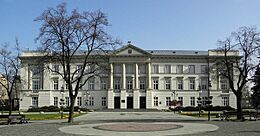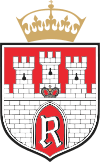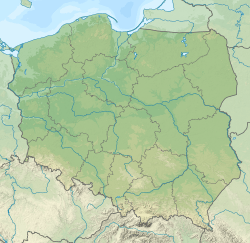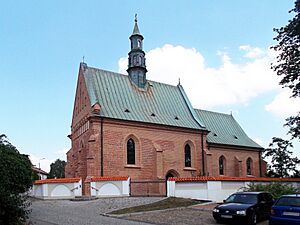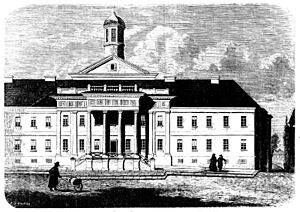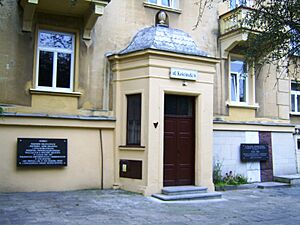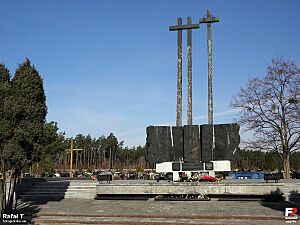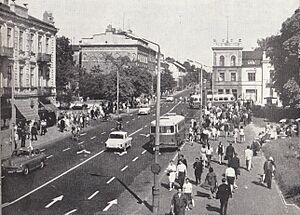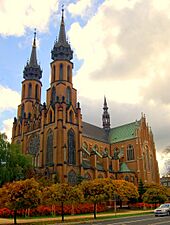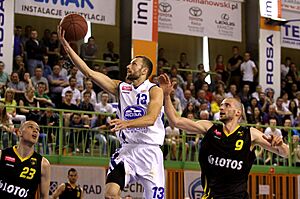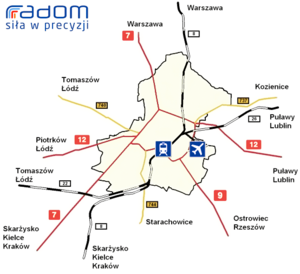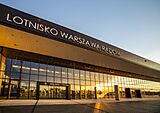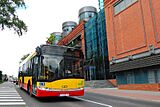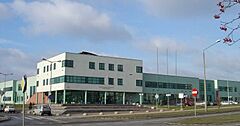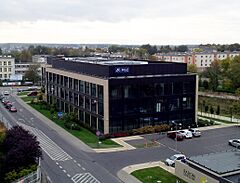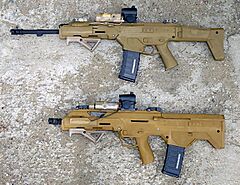Radom facts for kids
Quick facts for kids
Radom
|
|||
|---|---|---|---|
|
|||
|
|||
| Country | |||
| Voivodeship | |||
| County | Radom County (powiat radomski) | ||
| First mentioned | 1155 | ||
| City rights | 1364 | ||
| Area | |||
| • Total | 112 km2 (43 sq mi) | ||
| Population
(30 June 2023)
|
|||
| • Total | 196,918 |
||
| • Density | 1,761/km2 (4,560/sq mi) | ||
| Time zone | UTC+1 (CET) | ||
| • Summer (DST) | UTC+2 (CEST) | ||
| Postal code |
26-600 to 26-618
|
||
| Area code(s) | +48 48 | ||
| Car plates | WR | ||
| Primary airport | Radom Airport | ||
| Website | http://www.radom.pl | ||
Radom is a city in east-central Poland. It is about 100 kilometers (62 miles) south of the capital city, Warsaw. Radom is located on the Mleczna River in the Masovian Voivodeship. It is the 15th largest city in Poland. As of June 2023, about 196,918 people live there.
For many centuries, Radom was an important part of the Kingdom of Poland. It was a key place for government decisions. For example, the Pact of Vilnius and Radom was signed here in 1401. This agreement made the union between Poland and Lithuania stronger. Important laws like the Nihil novi were also passed in Radom in 1505. In 1976, the city was a center for protests against the government.
Today, Radom is famous for the Radom Air Show. This is the biggest air show in Poland and happens every two years. The city also has the International Radom Jazz Festival and the International Gombrowicz Theater Festival. Radom is also known for producing military firearms, including the "Radom" pistol.
Contents
Radom's Past
Radom started as a small settlement around the 8th or 9th century. It was an early medieval town near the Mleczna River. By the 10th century, it became a fortified settlement called Piotrówka. This place was protected by walls and a moat. Radom grew quickly because it was in a good location, close to important borders.
The first time Radom was mentioned in writing was in 1155. This was in a document from Pope Adrian IV. The name "Radom" comes from an old Slavic name, Radomir. It means "a fortified place that belongs to Radomir." The oldest church still standing in Radom is St. Wacław, built in the 13th century.
Growing into a City
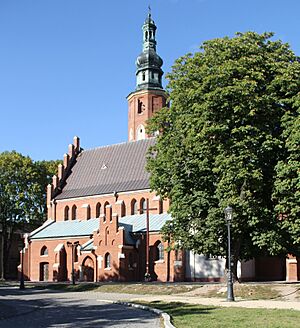
In the late 1200s, Radom became a town with special rights. In 1350, King Kazimierz Wielki (Casimir the Great) built a "New Town." This included a royal castle, strong defensive walls, and a town hall. The New Town had a market square and streets laid out in a grid pattern. The walls were about 1,100 meters long and had three gates and 25 towers.
In 1364, Radom received new, more modern city rights called Magdeburg rights. This gave residents more benefits. Radom was on an important trade route for cattle. In 1376, it became the seat of a local official called a starosta. This began a time of great success for the city.
Poland's Golden Age in Radom
Many Polish kings visited Radom and gave the city special rights. King Władysław Jagiełło often stayed at Radom Castle. In 1401, the Pact of Vilnius and Radom was signed here. This important agreement made the union between Poland and Lithuania stronger.
King Casimir IV Jagiellon and his wife also visited Radom often. They hosted important visitors from other countries at the castle. In 1489, the Grand Master of the Teutonic Knights paid respect to King Jagiellon in Radom. A famous early Polish composer, Mikołaj Radomski, came from Radom.
In 1481, Prince Saint Casimir, son of King Jagiellon, lived in Radom. He later became a patron saint of the city. During the rule of King Alexander Jagiellon, a very important law called Nihil novi was passed in Radom in 1505. This law meant that no new laws could be made without the agreement of the Polish Parliament (Sejm).
Radom was a royal city and an important center for the Sandomierz Voivodeship. It also controlled taxes for a long time. Many kings visited the city. However, in 1623, many people died from a disease. In 1628, a big fire burned half of Radom.
The city's good times ended during the Swedish invasion of Poland in 1655. The Swedish army took over Radom. The city was looted and almost completely destroyed in 1656. Its population dropped from about 2,000 to just 395 people. The royal castle and monastery were burned.
Modern Times in Radom
Radom was part of Poland until 1795. Then, it became part of the Austrian Empire for a few years. After a Polish victory in 1809, it joined the Polish Duchy of Warsaw. From 1815, Radom was part of Russian-controlled Poland. It remained an important regional center.
In the 19th century, Radom became a leading center for photography in Poland. A sewage system was built in 1867. In 1885, a railway line connected Radom to other cities. In the early 1900s, a power plant was built. During World War I, the Austrian army took over Radom in 1915. They stayed until 1918.
Radom in the Second Polish Republic
After Poland regained independence, Radom became part of the Kielce Voivodeship. In the late 1930s, many new factories were built as part of a government plan. By 1938, Radom's population grew to 80,000 people. The city was also a military base.
Radom During World War II
On September 1, 1939, World War II began with Germany's invasion of Poland. German planes bombed Radom. On September 8, 1939, the German army captured the city. They immediately took food and supplies. They also set up temporary prison camps for Polish soldiers. Conditions in these camps were very bad, but local people helped many prisoners escape.
The Germans closed schools and sports clubs. They banned teaching Polish history and literature. From 1939 to 1940, they carried out public executions of Polish civilians. Many Poles from Radom were also killed by the Russians in the Katyn massacre in 1940. Thousands of Poles were sent from Radom's prison to concentration camps like Auschwitz.
In October 1940, the Germans created a forced labor camp for Jews. In 1941, they created the Radom Ghetto, where 34,000 Jewish people were forced to live. Most of them later died at the Treblinka extermination camp. Helping Jewish people outside the ghetto was punishable by death. However, a secret Polish group called Żegota helped Jewish people in the city.
Radom was an important center for the Polish resistance. Many groups worked secretly to fight the Germans. They stole weapons, ran secret schools, and even made weapons in a factory taken over by the Germans. In 1942, the Germans found out about this and killed 50 Poles. Polish scouts helped save lives by destroying letters to the German secret police. In April 1943, the resistance successfully killed the head of the local German police.
In 1944, after the Warsaw Uprising, the Germans sent thousands of people from Warsaw to Radom. These were mainly older people, sick people, and women with children.
On January 16, 1945, the city was captured by the Red Army. Radom was returned to Poland, but a communist government was put in place. In September 1945, the Polish resistance attacked the communist prison and freed almost 500 prisoners. Before World War II, Radom had a large Jewish population, making up about 39% of the city.
Recent Events
From 1975 to 1998, Radom was the capital of its own province, the Radom Voivodeship. In 1954 and 1984, the city grew a lot by adding nearby towns and villages as new districts. In 2007, Radom was a main center for a strike by Polish healthcare workers.
Radom's Location and Weather
Climate
Radom has a humid continental climate. This means it has warm summers and cold winters.
| Climate data for Radom | |||||||||||||
|---|---|---|---|---|---|---|---|---|---|---|---|---|---|
| Month | Jan | Feb | Mar | Apr | May | Jun | Jul | Aug | Sep | Oct | Nov | Dec | Year |
| Daily mean °C (°F) | −4.7 (23.5) |
−3.3 (26.1) |
2.1 (35.8) |
8.4 (47.1) |
13.2 (55.8) |
16.4 (61.5) |
18.0 (64.4) |
17.4 (63.3) |
13.7 (56.7) |
8.8 (47.8) |
3.2 (37.8) |
−1.9 (28.6) |
7.6 (45.7) |
| Average precipitation mm (inches) | 26 (1.0) |
25 (1.0) |
28 (1.1) |
37 (1.5) |
59 (2.3) |
76 (3.0) |
79 (3.1) |
66 (2.6) |
45 (1.8) |
36 (1.4) |
38 (1.5) |
34 (1.3) |
549 (21.6) |
| Source: Climate-Data.org | |||||||||||||
Interesting Places to See
Radom has many historical buildings and parks to explore:
- St. Wenceslaus Church: This is the oldest church in the city, built in the 13th century.
- St. John the Baptist Church: Founded by King Casimir III, built in the 1360s.
- Bernardine Church and monastery: Built between 1468 and 1507.
- Holy Trinity Church: Built in the 1600s in a Baroque style.
- Gąska's and Esterka's Houses: Old houses from the 16th and 17th centuries.
- Sandomierz Palace: A grand building designed in a classical style, built in the 1820s.
- City Hall: Built in the 1840s.
- Cathedral of Virgin Mary: Built in a Gothic Revival style around 1900.
- Tadeusz Kościuszko Park: A lovely park that opened in 1867.
- Radom Air Show: The biggest air show in Poland, held every two years.
People in Radom
| Historical population | ||||||||||||||||||||||||||||||||||||||||
|---|---|---|---|---|---|---|---|---|---|---|---|---|---|---|---|---|---|---|---|---|---|---|---|---|---|---|---|---|---|---|---|---|---|---|---|---|---|---|---|---|
|
|
|||||||||||||||||||||||||||||||||||||||
Radom's Culture

Arts and Entertainment
- Music: The Radom Chamber Orchestra was started in 2007.
- Cinemas: You can watch movies at Elektrownia, Helios, or Multikino.
- Theatre: The Jan Kochanowski Theatre offers plays and performances.
- Museums and Galleries:
- Jacek Malczewski Museum
- Modern Art Museum
- Scouting Museum
- "Elektrownia" - a former power station now an art gallery.
Sports in Radom
Radom has several sports teams that compete at high levels:
- Rosa Radom: A men's basketball team that plays in Poland's top league.
- Czarni Radom: A men's volleyball team, founded in 1921, playing in Poland's top league.
- Radomiak Radom: A men's football team, founded in 1910, playing in the top football league.
- Broń Radom: Another men's football team, founded in 1926.
Getting Around Radom
Radom is an important place for trains. Two main railway lines meet here: one goes from Lublin to Łódź, and another from Warsaw to Kraków. The city is also near important European roads. The Radom Airport is only about 3.5 kilometers (2.2 miles) from the city center. This is where the famous Radom Air Show takes place.
- Transport in Radom - Gallery
Learning in Radom
Radom has about 20 schools for higher education, including:
- University of Radom
- University College of Environmental Sciences
- Higher Business College
- Higher Financial and Banking College
- Higher Merchant College
Other Interesting Facts
- The Łucznik Arms Factory in Radom makes different types of military firearms, like assault rifles.
- The book Outcry - Holocaust Memoirs by Manny Steinberg tells the story of a young Jewish man's life during the Nazi occupation of Radom.
- The Kurc family in the novel We Were the Lucky Ones by Georgia Hunter lives in Radom at the beginning of the story.
Radom's Sister Cities
Radom has "twin towns" or "sister cities" around the world. These are cities that have special friendly relationships.
|
|
Radom used to be twinned with Homyel in Belarus and Ozyory in Russia. However, on February 28, 2022, Radom ended these partnerships because of the 2022 Russian invasion of Ukraine.
Famous People from Radom

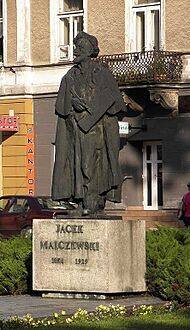

Many notable people were born, lived, or worked in Radom, including:
- Mikołaj z Radomia (around 1400–1450), a medieval composer.
- Jan Kochanowski (1530–1584), a famous Renaissance poet.
- Jacek Malczewski (1854–1929), an important Polish painter.
- Leszek Kołakowski (1927–2009), a well-known philosopher.
- Andrzej Wajda (1926–2016), an Academy Award-winning film director.
- Zygmunt Solorz-Żak (born 1956), a successful entrepreneur and billionaire.
See also
 In Spanish: Radom para niños
In Spanish: Radom para niños




